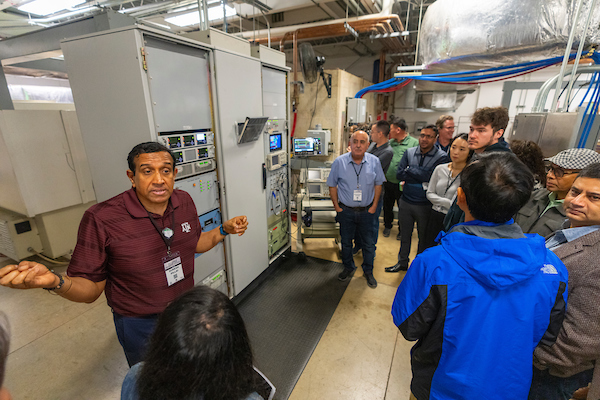Texas A&M AgriLife, NASA explore potential collaborative interests
Enhancing space flight nutrition, health highlighted in symposium
Texas A&M AgriLife and NASA explored further research opportunities in human space flight spanning topics covering food, nutrition and health during a recent collaborative online symposium.
Organizers included Texas A&M AgriLife, Prairie View A&M University College of Agriculture and Life Sciences, NASA’s Johnson Space Center Human Health and Performance Directorate, NASA Human Research Program and Translational Research Institute for Space Health.
Food and space
“There are great opportunities for collaboration between AgriLife and NASA,” said Patrick J. Stover, Ph.D., vice chancellor of Texas A&M AgriLife, dean of the College of Agriculture and Life Sciences and director of Texas A&M AgriLife Research. “Agricultural expectations have changed from the production of food, fiber and fuel to new expectations of producing food that maintains lifelong health of populations. We are positioned to collaborate with NASA to explore new frontiers in understanding the importance of food, food safety and food systems both on Earth and in space.”
John Sims, director of human health and performance at the NASA’s Johnson Space Center, said NASA’s mission is not limited to space flight, but also includes driving advances in science, technology, aeronautics and space exploration to enhance the economic vitality of Earth.
“And that ties very well into what AgriLife does; this is an outstanding opportunity to advance areas of mutual interest,” Sims said. “We are working to return humans to the moon and then on to Mars; this is an enormous undertaking with many challenges. We can’t do this without help from Texas A&M, Prairie View A&M and other institutions. There is a lot of research to be done to address and mitigate all the human risks associated with long-duration spaceflight. For example, we have to develop unique and viable food systems to get us to Mars and back.”
Symposium tracks and topics covered precision health and genomics, translational research and grant opportunities.
eBeam research
Texas A&M AgriLife has already played a key role in space food research and development. Since 2005, AgriLife Research has played an integral role in enabling NASA’s Johnson Space Center to prepare food for its astronauts in the space shuttle and space station programs.
AgriLife Research’s National Center for Electron Beam Research at Texas A&M University in Bryan-College Station, which specializes in eBeam technology, uses high beam electrons accelerated at almost the speed of light and can be used in a variety of environmental and food cleaning applications and even space food applications. The center has previously partnered with NASA on various projects including developing eBeam-dosing protocols for NASA space food applications.
“This technology can be used anywhere on Earth or elsewhere,” said Suresh Pillai, Ph.D., eBeam center director. “eBeam processing is highly applicable to space food processing. We have the ability to customize specific doses to single pouches in addition to large batches. It has significant advantages to Cobalt 60, which is the legacy technology since it’s not radioactive material in use.”
Other potential research is using freeze-dried technology for fruits and berries to prevent fungal contamination during storage and travel. Pillai said eBeam could be applied to space travel apparel, possibly limiting the number of apparel items needed for a mission and sterilizing the containers bringing samples back from Mars.
Nourishment in space
Optimal nourishment for space flight is not just about providing the right amount of nutrients or functionality in foods in zero gravity, said Janet Antwi, Ph.D., R.D., assistant professor at Prairie View A&M. The food needs to be easy to consume, require minimal water and provide variety.
“One thing of great concern is the variety and choices the astronauts have to make the meal tasteful and enjoyable,” she said.
Food and mealtimes are the most significant connection astronauts feel to home, heavily affecting their morale, happiness and well-being, she said. Despite all the great advancements, it still remains a major issue and concern regarding how appetizing the food is to the astronauts.
“Options, variety and flavors all play essential roles and are limited in space,” Antwi said. “As dieticians, no matter how nutritious the food is, if it’s not palatable or lacks variety, it will not be consumed. Now, space missions are lasting six months and up to three years for future space missions to Mars and the moon, so I think this is a great issue NASA is trying to address.”
Antwi said current research projects include growing fresh fruits and vegetables in space to boost freshness and nutritional content of food, as well as a 3D food printing project where nutrient-laden ingredients are fed into the printer, mixed and printed for consumption.
“We can possibly produce food based on taste and texture preference,” she said. “We see this as an opportunity to design eating experiences to give astronauts the ‘ah-ha moment’ with their food intake, mimic the sensory aspect of freshness and flavor, and have all of the emotional and social aspects of eating that we enjoy here on Earth each day,” she said.






